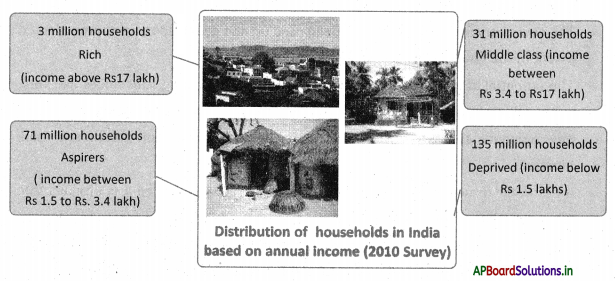Students can go through AP State Board 10th Class Social Studies Notes Chapter 12 Sustainable Development with Equity to understand and remember the concept easily.
AP State Board Syllabus 10th Class Social Studies Notes Chapter 12 Sustainable Development with Equity
→ The rapid expansion of production and incomes can coexist with malnutrition and lack of education and health for a large proportion of the people, as in India.
→ With a high percentage of the workforce in low-paid employment, an increase in GDP and the enormous variety of goods and services being produced can benefit only select groups.
→ Wide inequalities like a few enjoy world-class living comforts and others deprived of decent living cannot be the basis for a society.
→ The environmental resources have been used up and damaged to an unprecedented extent in the course of economic growth.
→ The potential of an environment to provide naturally existing substances like land, water, minerals, etc. is referred to as an “environment’s source function”.
→ The environment’s ability to absorb and render harmless waste and pollution is “Sink function”.
→ If the water drawn up is more than that is being recharged, then it is obvious that after some time no more groundwater is left.
→ Groundwater overuse is particularly found in Punjab and Western U.P, hard rock plateau areas of central and south India, some coastal areas, and urban settlements.
→ Sustainable development is the development that meets the needs of the present without compromising the ability of future generations to meet their own needs.
→ Only one percent of the pesticide actually acts on the pest – the rest goes into our system through food, water, and the environment.
→ Modern industrial development and agricultural development are intensive in the use of natural resources including energy, depletion of resources, and pollution of the environment is to be expected.
→ Organic farmers forego the use of chemical fertilizers and pesticides. c& Sikkim is the first state in India that is planning to shift completely to organic farming by 2015.
![]()
→ Uttarakhand too is following the same path of being 100%
→ From development centered on the growth of goods and services, the goal has to shift towards sustainable development with equity.
→ Sustainable development: That meets the needs of the present without compromising the ability of future generations to meet their own needs.
→ Environment: The surroundings of us on the earth which show some effect on us.
→ Source: The place something comes from or starts at, or cause of ‘something.
→ People’s rights: The right entitled to the people by the constitution.
→ Equity: Th quality of being fair or Impartial, fairness.
→ Sink: An environment’s ability to absorb and render harmless waste and pollution.
→ Gross Domestic Product: The total money value of all the goods and services produced In the country during a year which exclude the money from abroad
→ Per capita income: The National Income of a country d1vI(d by Its population gives per capita income.
→ Human Development Index: A composite Index based on life expœtary, general health level, literacy rate, and education sanitation facilities besides per capita income.
→ Social indicators: The Indicators which show some effect on society either with change In Income or any other changes.
→ Unorganized sector: Refers to household-based production activities and small and tiny seétors of industry like handicrafts, handlooms, etc.
→ Organized sector: Refers to large-scale Industrial and agr1cultiral units with a defined pattern of production and employment.
![]()
→ Economic development: SustaIned economic growth with Institutional changes refer to economic development.
→ Economic growth ¡it refers to an Increase In the production of goods and services arid their value, considerably, over a year.
→ Natural resources: The resources that are naturally existing substances like land, water, minerals, ores, etc,
→ Environment’s source: The potential of an environment to provide the function natural resources like land, water, minerals, ores, products from trees and animals, etc.
→ Carrying capacity of the environment: The capacity of the environment to support economic production and consumption In the future.
→ Recharge (of water): The water bu to go dàwflto thè ground for It to be lifted up.
→ Unsafe drinking water: The water that Is contaminated from chemical and industrial waste.
→ Diversity: The existence of a large number of different kinds of animals and plants.
→ Multiple cropping: Raising of more than one crop simultaneously in the same piece of land.
→ Displacement: The act of displacing the (tribal) people in the areas which are believed to be submerged with the construction of the dam
→ Traditional knowledge: The stock of knowledge has been built and enriched over generations.
![]()
→ Greenhouse gases: The gases like CO2 that cause the problem of a gradual rise in the temperature of the earth’s surface.
→ Organic farming: The practice of cultivation without using chemical fertilizers and pesticides.
→ Crop rotation: The act óf changing the crop that is grown on an area of land in order to protect the soil.
